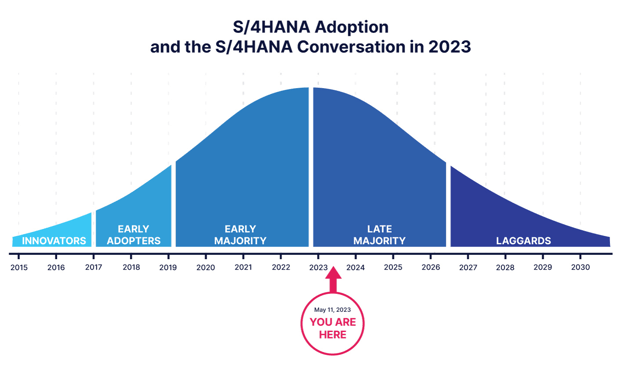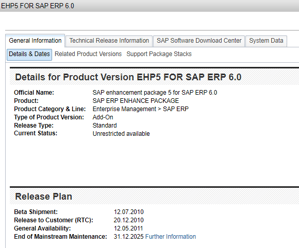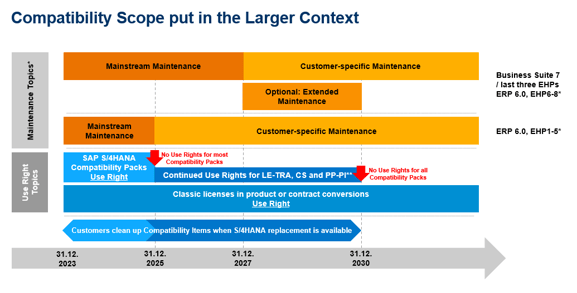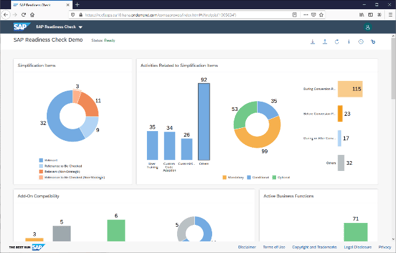Still on SAP ECC? Is your platform burning?

Time is running out faster than you think!
By Cédric Sauzereau - SAP Advisor and Business Development Principal - SAP Business Solutions
If you are reading this, you are probably part of the “late majority” still trying to understand why, when and how to move to SAP S/4HANA and thinking, “We still have time, right? SAP said end-of-life for ECC was 2027—and if they moved the date once, they’ll probably move it again.”
“Mark my words: the clock is ticking and your platform is likely already on fire without you realizing it!”
In this blog, I will give you some general considerations to help assess your situation. For details about your specific situation and the best plan of action, contact me for a one-to-one conversation.
The late majority

SAP released its first real version of SAP S/4HANA, known as the 1511 release, in November 2015. If you have “Simple Finance”, you are not on S/4HANA but a hybrid release—an ECC 6.0 EHP8 release with some S/4HANA features for finance embedded within.
Since 2015, SAP has been trying to reach customers, imploring them to move to S/4HANA sooner rather than later.
Where are we eight years later? Those who understood the business benefits and could communicate them effectively to their teams and management, and probably a fair few who remembered all the fear around Y2K, took action early and moved or are currently transitioning.
But the ugly truth is that the vast majority of SAP’s install base has held fast to their ECC 6.0 platforms, whether they’re unconvinced of S/4HANA’s advantages or because they think they still have plenty of time and that such a “technical” project would take up valuable bandwidth.
The fact of the matter is that it is not a technical project! Those early adopters were able to sell the technical conversion to their board because they understood the underlying business benefits of re-platforming to S/4HANA: reduced stockouts, lead times, logistics and manufacturing costs—all this and more make for an attractive business case.
But if you’re still on ECC 6.0, eight years after the launch of S/4HANA, you are not alone. You’re part of what we call the “late majority”.
Is it 2025 or 2027?
Ok, no more blaming—you are still on ECC 6.0, so what should you do?
First, are you on ECC 6.0 Enhancement Package 6 (EHP6) or above?
When SAP announced they’d moved the S/4HANA upgrade deadline, the devil was in the fine print:
“If you are not on ECC 6.0 EHP6 or above, your ECC end-of-life is still Dec. 31st, 2025!”
Enhancement Package 5 or older
Many customers think they have four years to move to S/4HANA, regardless of which EHP they’re running.
If you are still on ECC 6.0 EHP5 or below, you need to have completed your transition to S/4HANA before Dec. 31st, 2025. Otherwise, you will fall out of mainstream maintenance as of Jan. 1st, 2026.
And your move to S/4HANA will surely require more than 12 months.
As a matter of fact, a typical re-implementation (known as Greenfield) will take somewhere between 10 and 15 months, depending on your size, scope and the complexity of your existing processes.

If you choose the “conversion” path (a.k.a. Brownfield), the fact that your platform is not “S/4HANA ready” makes the migration more complex. You might need pre-steps projects, such as Unicode conversion before even starting the S/4HANA conversion. We are talking about a two-year project to manage all this!
So, is your platform burning? Yes!
You need to budget two years’ worth of project and licensing right away and launch your conversion or re-implementation early in 2024!
Enhancement Package 6 or newer
If you are on EHP6 or above, the conversion to S/4HANA may be simpler. But don’t think you are out of the woods yet; you don’t have much time to spare, either. You may technically have until Dec. 31st, 2027, but again the devil is in the details.
Compatibility packs, Unicode conversion requirements, security threats, outdated hardware, resource scarcity… these and many unforeseen complications should push you to act earlier.

Compatibility packs
Who knows about compatibility packs? Almost no one! Many existing SAP ECC 6.0 customers aren’t even aware they’ll face this issue when moving to S/4HANA.
Put simply, compatibility packs are bundles of old ECC functionality that SAP is allowing you to keep embedded in S/4HANA until they release a replacement feature native to S/4HANA.
If you have HR; Payroll; Multiresource Scheduling (MRS); Environment, Health, and Safety Management (EHS); Work Manager; Configure Price Quote (CPQ); Travel (FI-TV), etc., those functionalities are tolerated in S/4HANA as compatibility packs until Dec. 31st, 2025. Some cases are even tougher, like Vistex 6.1 which is not supported anymore in S/4HANA since the end of 2021 and requires implementation of new Vistex V/4 when moving to S/4HANA.
That means, on top of having to convert/upgrade to S/4HANA, you’ll need to replace those ECC features with the rough equivalents native to S/4HANA before the end of 2025.
I say “rough equivalent” because sometimes you won’t have a perfect functionality pairing and will need to go through the S/4HANA simplification list to realize that you’re actually implementing a new product with new features—which means additional change management!
For example, replacing MRS and Work Manager (mobility) with S/4HANA Asset Management for resource scheduling and SAP Asset Manager is a full-blend functional project that needs to be taken care of after technical conversion to S/4HANA.

So, where am I going with this?
“If you think you have four years to make the jump because you are on EHP6 or above, you are probably wrong.”
You’d likely need to convert to S/4HANA soon—like, early in 2024—to be able to start an MRS replacement project (example above) in 2025.
If you wait and try to mix the technical conversion with new feature implementation, it’ll be a nightmare.
We strongly recommend doing a pure technical conversion first before diving into new functionality.
S/4HANA resource apocalypse
I was skeptical two years ago when I started reading articles about the “S/4HANA resource apocalypse”.
But they were right.
“We are heading towards a major storm in 2025-2027.”
SI’s like us are already almost fully hired out, and the labor shortage is not helping.
Waiting another two years to launch your S/4HANA project will be like scouring the grocery store for a turkey at 7:00 p.m. on Christmas Eve.
So, I urge customers to start booking their S/4HANA projects now or in early 2024 in order to execute successfully.
Should you go Brownfield or Greenfield?
So, should you convert (Brownfield) or reimplement (Greenfield)? Another big question.
.jpg?width=624&height=566&name=graphic-03%20(1).jpg)
There’s no one good answer, so instead I’ll go over some basic considerations.
If your SAP ECC 6.0 is not too outdated, not too customized (solution enhancements, Z code/transaction) and if it still fits most of your business needs as-is, go for Brownfield. Protect your past investment, the value-added solution enhancements, and go fast on S/4HANA through a system conversion. It is faster and cheaper.
Re-implementation (Greenfield) is more bandwidth intensive and disruptive, especially for the business people in your organization. But it is surely the best option in the long run if your ECC 6.0 is outdated, processes implemented back then are too far from today’s reality, particularly if you have a ton of Z code or transactions that are now replaced by standard functionality. If you’re in this boat, your ECC 6.0 is an “innovation blocker”.
However, only conducting a detailed analysis using some SAP tools (Readiness Check, Business Scenario Recommendations/Process Discovery, etc.) and building a roadmap can truly tell you what your best path forward is.

What about the deployment model? Cloud or on-premise?
If you were thinking about keeping your system on-premises, consider this:
- 62% of Canadian organizations were subject to ransomware attempts in 2021, according to a PwC study published in 2022
- The average cost of a data breach is about $6,000,000
- Hyperscalers—like AWS, Azure or Google Cloud Platform—provide up to ten times the security your data center can, and for a fraction of the cost
“The world is now in the cloud, and ERPs are no exception!”
Within the last two years, SAP has launched their RISE with SAP offer with a certain focus on current customers willing to move to S/4HANA. The offer is hard to ignore as it is now attractive and many customers are moving this way as we speak.
Given that staying on-premise also means acquiring new HANA-certified hardware to be managed by yourselves or a partner in your own data center (including infrastructure, operating system, database, backups, disaster recovery, security patches and more), there must be a really good reason not to choose the cloud and the RISE with SAP path.
What about costs and budgeting?
Again, it depends.
Since the world exists ever more on the cloud, SAP will not grant discounts for on-premises licenses as they have in the past. So be prepared to pay the price for staying on-premises rather than embracing the cloud and the RISE with SAP offering.
On-premise
SAP has been giving incentives to early adopters moving to S/4HANA through either a “product conversion” or a “contract conversion”.
Product conversion was an inexpensive scenario that involved buying a “bridge” SKU called “S/4HANA Enterprise Management for ERP customers” and paying the 15% fee for the HANA database. After eight years of incentives, SAP has retired this option.
What’s left is the “contract conversion”. This scenario means terminating all your ECC licensing and buying a new S/4HANA license BOM (bill of material) at a discount (SAP’s way of showing appreciation for your past investment). SAP calls this discount “conversion credit”.
Here’s an example:
You’ve purchased $1,000,000 worth of SAP ERP licenses over the past 20 years with around $220,000 in annual maintenance fees. When doing the contract conversion, your new S/4HANA BOM comes out to $1,500,000. SAP used to recognize 100% of your past investment as conversion credit, allowing you to buy S/4HANA for the difference—$500,000—with just an additional $110,000 to your annual maintenance bill.
Incentives on the contract conversion path have also been shrinking over time. The longer you wait, the smaller your conversion credit will be.
RISE with SAP (Cloud)
If you are willing to move to the cloud as you transition to S/4HANA, RISE with SAP is the way to go.
SAP will terminate your whole on-premise license BOM the day you sign a RISE with SAP subscription agreement and will give you some incentives to make the business case more attractive.
We want to help you build your business case and capture all costs and possible savings. So please get in touch and ask us to simulate RISE with SAP licensing (or ask your current partner, if they’re familiar with the service).
There’s also a new program, STAR (S/4HANA Trusted Authorization Review), for those willing to let SAP do a deep dive into your ECC usage. Based on your data, SAP will create a custom RISE with SAP BOM to fit your unique needs.
But be careful what you wish for. SAP STAR will look at licenses, transactions, roles and authorizations, meaning they could uncover non-compliance in your current ECC usage!
Regarding re-implementation or conversion costs
This is another very customer-specific concern.
If your initial implementation was $2,000,000 and you spent an extra $1,000,000 on subsequent projects, please consider that re-implementation won’t be any cheaper. It may very well cost more this time around. Remember, we’ve seen probably greater than 20% inflation over the last decade.
If you are walking the conversion road, depending on your size, complexity, your source release and the number of pre-steps or post-steps required (Unicode, compatibility packs, etc.), you can expect the project to cost between $500,000 and $1,500,000.
Conclusion
So, back to the initial question: is your platform burning?
- If you are on ECC 6.0 EHP5 or below, the answer is a resounding YES!
To paraphrase what someone from SAP recently said, “If you are in this situation, you have not been a good steward of corporate funds”. You should act now and start a project in early 2024, no matter the chosen deployment model (on-premise or cloud) and scenario (Greenfield or Brownfield).
- If you are on ECC 6.0 EHP6 or above, temperatures are rising rapidly!
If you are in this situation, I strongly recommend you contact me at cedric.sauzereau@createch.ca or contact your local S/4HANA partner ASAP to start the discussion. We need to look closely at your specific situation. You might have less time than you originally thought.





